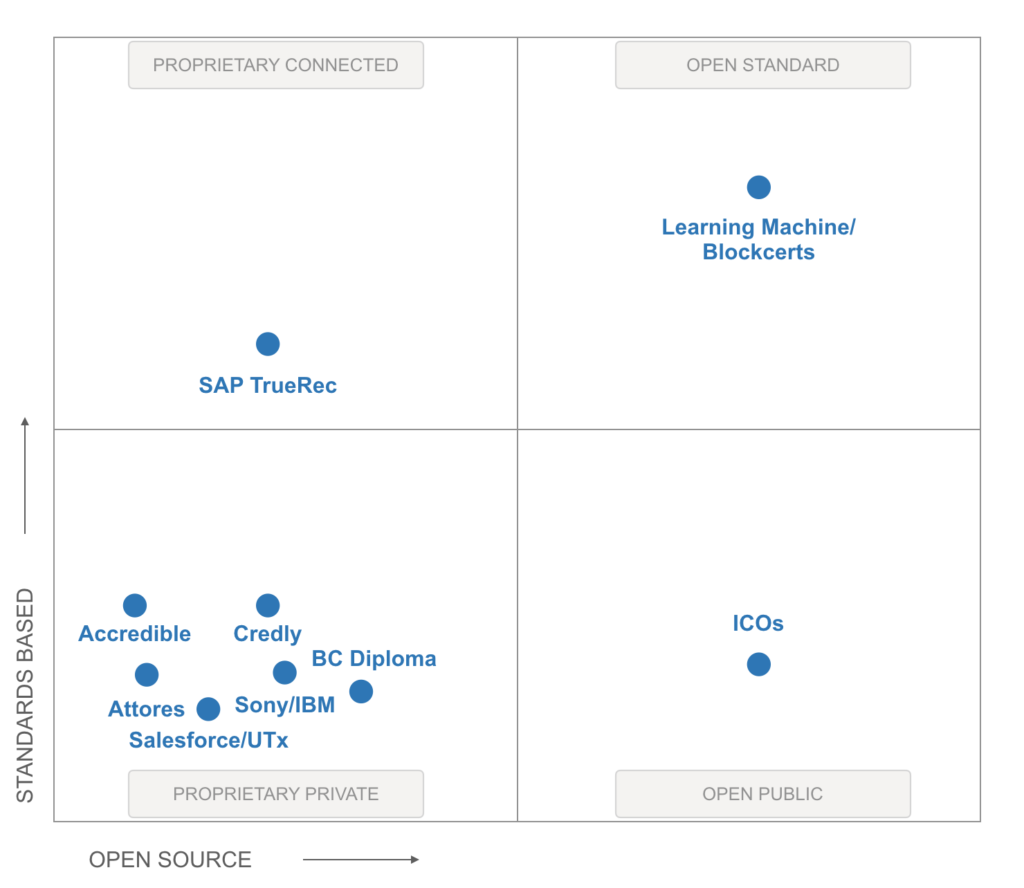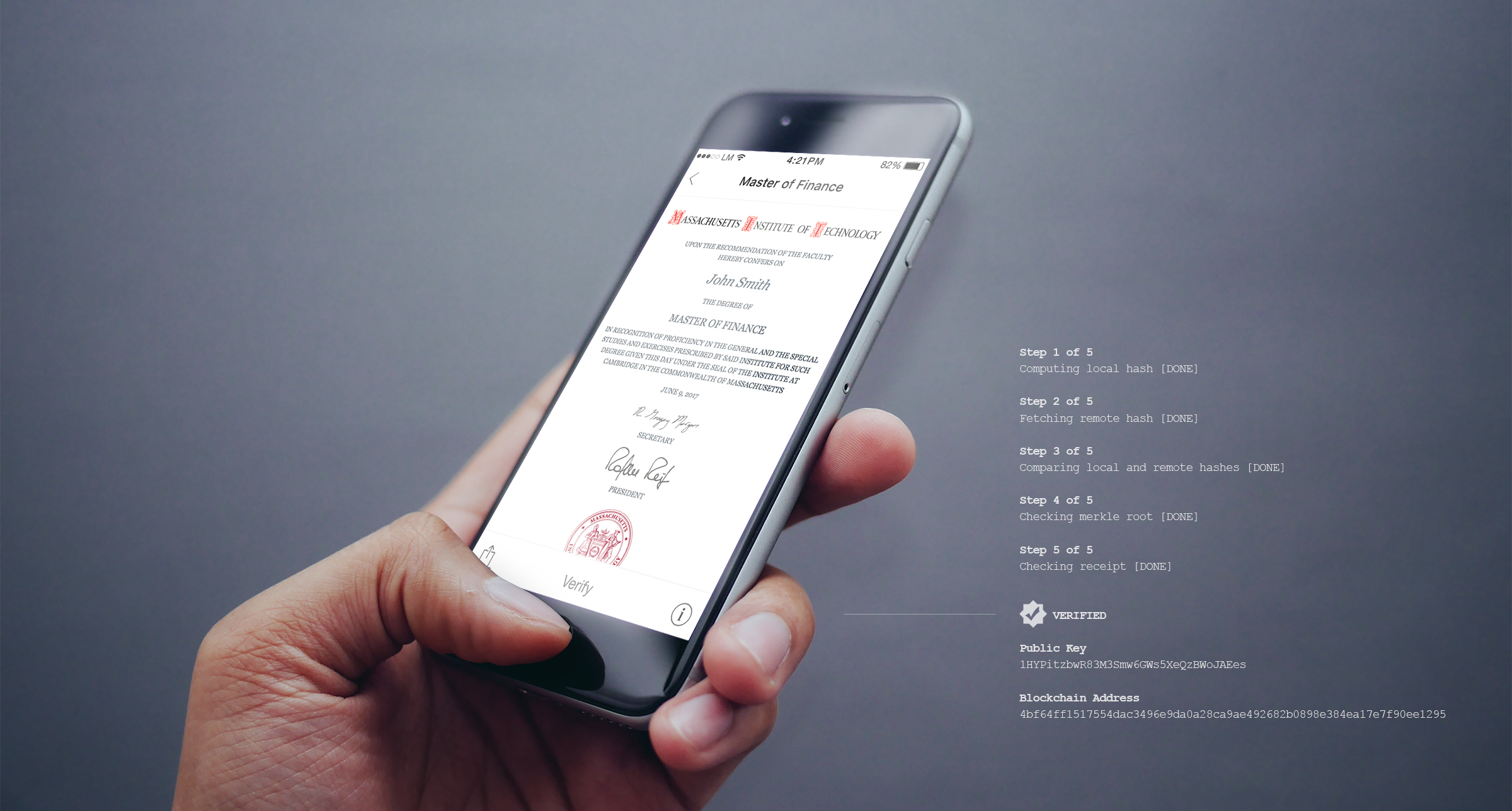Blockchain in Education
A growing forest of choices for securing academic credentials means starting with open standards or betting on vendors.

The blockchain revolution has recently come to the education sector with the promise of providing tamper-proof credentials that facilitate student ownership and use of academic records. This means students can share their official records directly with anyone and have them be trusted as authentic. In other words, these records no longer have to be transmitted by a third party, which is a fundamental break from the typical vendor-controlled ecosystems where rents must be paid to store or transmit official records.
Most vendors perceive the swelling interest in the promise of this new technology and are responding with PR announcements about their intentions to enter this space. For example, Sony/IBM, SAP/TrueRec and Salesforce/UTx, Accredible, and Credly have all announced proprietary systems that use a blockchain to create verifiable records. Is this good news? While the press releases are savvy enough to signal awareness of core values like “immutability” and “ownership,” they aren’t actually implementing those values. In fact, they are doing the opposite.
The goal of this article is to provide simple descriptions of these vendor-centric initiatives and contrast them with more significant developments in the area of open standards, which are actually beginning to deliver on the promises of decentralization.
Previously, we’ve discussed how different types of products can by the organized by the principles of recipient ownership and vendor independence. Both are required to actually achieve a state known as self-sovereign identity. This is a term that encapsulates many principles, which together add up to people owning things and operating in the world without dependence upon brokers or centralized authorities. When translated into the educational domain, that means that once a student attains academic achievements, they can prove that those achievements are theirs without having to pay money, wait a long time, or suffer any of the other inconveniences that arise from the legacy complexity of proprietary infrastructures.
The challenge with reviewing the big vendor announcements is that they don’t actually have products yet, and it is not clear in what ways they are using open standards or public blockchains. These two points mean that they are likely recreating the old model of vendor dependency that precludes true ownership of records and interoperability across vendor systems. The first instinct of big technology vendors is to seize control of new possibilities with proprietary formats. Remember AOL Instant Messenger? Remember the Blackberry? These were successful for a short time, but were forced to adapt once open standards emerged. SMTP made email ubiquitous. XMPP became the foundational layer for instant messaging. All of these protocols were stacked on top of previous ones (TCP/UDP), and those were built on top of a foundational standard (IP). Standards build upon and connect with each other, creating the soil that allows for a variety of future products to flourish.
Attempts to create new technologies independent from existing standards are typically exclusionary and short-lived, which is a worst-case scenario for important records that need to last a lifetime.
Mapping the Vendors
To better understand the PR announcements of large vendors, we need to have a value system. Given that products in the blockchain space are just emerging, our highest values should be laying the groundwork of open standards that enable a new generation of records and products that interoperate. Without open standards, we condemn a generation of students to proprietary silos that aren’t useful outside of a vendor’s walls and are guaranteed to disappear in just a few years. So, here is the same organizational structure with focus on educational vendors.

These four quadrants emphasize different things, but it is only the top right quadrant that contains the hope for a truly decentralized system that empowers individuals. While some people take comfort in big-name brands, the other quadrants are just old models dressed in new clothes. Let’s take a look at a few.
Sony/IBM
Summary: Sony Global Education has decided to use Hyperledger Fabric to create a custom blockchain and to host that system using IBM’s cloud, which will provide the network infrastructure for issuing and verifying educational records.
Problems: Even if the their Hyperledger blockchain is open source, and even if they are able to build a large enough network to guarantee security, it remains to be seen whether the resulting credentials will truly be interoperable outside of this Sony ecosystem. If students get locked into the ephemerality of a Sony-controlled garden, there is essentially no different from existing systems that depend on a vendor for all services provided.
SalesForce/UTx
Summary: The University of Texas worked with developers from Salesforce.org to create an ecosystem for issuing, receiving, and verifying academic achievement using the MultiChain toolkit for private blockchains. The stated goal was ease-of-use for all stakeholders.
Problems: While this project generated some nice user interfaces, the prototype is akin to a private IT project. In addition to not having a network to run their private blockchain, the whole project is private, with no standards employed for its foundational layers. The entire system imagines that schools join a private network, operate as a node, and accept the data models and workflows of a particular institution. This isn’t even viable for most institutions.
SAP/TrueRec
Summary: SAP is developing a set of command-line libraries that use the Ethereum public blockchain to issue records of academic achievement, which they are piloting for a specific class on the OpenSAP MOOC. The codebase utilizes the Open Badge Specification for credentials, so some effort has been made to connect the system to other functional standards.
Problems: This offering is not open source nor positioned as a resource for others to use. SAP has developed a free iOS app, but it also isn’t open source, so it can’t be inspected or improved upon. The sole repository for these credentials is an SAP-controlled app. And even through they claim to be using the Open Badges spec, they aren’t using the V2 standard which employs the Blockcerts standard for blockchain verification. Further, they have also shared that the final digital format is a proprietary format called TRU.
Credly
Summary: Credly is a provider of open badges that has recently claimed to have added features for anchoring these badges to a blockchain. Evidence from Github shows they took a part of the Blockcerts issuing codebase and they are actively running pilots with several prominent partners.
Problems: Even though they downloaded part of the Blockcerts issuing codebase to get started, they are doing this without attribution. Further, it’s impossible to tell exactly what they are doing because they have not published or open sourced how their technology is working. This isn’t a standards-based approach to using the blockchain, which threatens the interoperability of these records. Further it is clear that they are not gathering public keys from recipients, so the resulting badges are not recipient owned or vendor independent.
Accredible
Summary: Accredible is a provider of digital certificates that has also claimed to have records that are blockchain verifiable. They are using Tierion to timestamp records, which is intended to show that records have not been tampered with since a particular point in time.
Problems: Timestamping alone adds very little value or security to records. Accredible records still depend on the vendor for hosting, viewing, and verifying. Further, these records do not contain the public key of recipients, so ownership can not be demonstrated.
Initial Coin Offerings
These are typically vendor-led initiatives to create a network fit to a specific purpose. A growing number of offerings are being marketed as addressing the nuances of a specific market, with one example being BCDiploma focusing specifically on university diplomas.
Problems: These offerings are usually vendor dependent and more importantly, attempt to reinvent the wheel unnecessarily. Rather than using existing standards and networks, vendor-based toolkits are fragile compared to public infrastructures. Attempting to create a cryptocurrency for such a limited use-case simply won’t gather the momentum or security needed for longevity and interoperability. The real damage of these initiatives is typically their marketing, which spread untruths in the attempt to gain attention and raise money for their ICO. For instance, BCDiploma has claimed that only their solution is GDPR compliant and that Blockcerts (below) puts personally identifiable information on the blockchain, which is simply false. This is incredibly damaging during a time when leaders are trying to get a handle on the facts.
Blockcerts
Summary: In 2016, when Learning Machine and MIT launched a system for issuing blockchain-based verifiable records to students (Blockcerts), it was assumed that the system should be open source, built on top of underlying standards, facilitate student ownership, and ultimately serve as a resource for others building similar systems so that a common standard would ensure interoperability of record verification. Blockcerts is a growing open sourced codebase for issuing, receiving, and verifying official records anchored on a blockchain (even private chains). The Blockcerts mobile app for recipients is on both iOS and Android, both of which are open source and available for any vendor to take and improve upon. Because the goal is to serve as a standard, development continues in close collaboration with other standards such as:
- W3c Verifiable Claims
- W3C Linked-Data Signatures
- IMS Open Badges
- W3C/Rebooting Web of Trust Decentralized Identifiers
Further, Blockcerts was designed to be configurable, so other standards can be employed to create valid documents for different domains. For instance, if an institution wants to use the PESC standard for transcripts rather than Open Badges for certificates, they can do so.
By offering an open source, standards-based resource, Blockcerts can be utilized by others and serve as a technical foundation for future innovation. And unlike the announcements from major vendors, which are largely aspirational, Blockcerts has been shipping open-source code for several years, with adoption growing internationally.
Learning Machine is a core contributor to Blockcerts and the first company to build a commercial product using this standard to issue credentials in a format that anyone can verify and that has no ongoing vendor dependence. This means that even if Learning Machine disappears, students own the certificates issued in perpetuity, which remain instantly verifiable by anyone.
For a great example of how to empower learners with blockchain credentials, check out the MIT Registrar’s case study on MIT News.

In Conclusion
It is helpful to distinguish between a social standard and a technical standard. One refers purely to adoption. The other refers to a set of engineering specifications that are open, available to use, and layered upon other standards. While vendors work hard to make the lock-in of a proprietary solution feel like a standard socially, these offerings are typically short-lived and, even when they are not, come barbed with the centralization and expense of vendor self-interest. These closed systems, in the context of blockchain credentials, would leave learners with a mess of conflicting formats that are not interoperable.
Simply using “blockchain technology” isn’t enough. It is the size and security of the decentralized network that creates the value. New systems create the greatest value when they empower people with recipient ownership, vendor independence, permanence, and privacy.
Even as some universities explore making their own blockchain networks, these miss the point and are simply a response to the unfounded fear that they might be giving up credentialing power to a public network. The power to credential always resides with the issuer. The blockchain network provides permanence and convenience for verifying those credentials.
It is our hope that major vendors and universities begin to develop and support open standards so that educational records can operate outside of walled gardens and work anywhere in the world. Anything else shortchanges both educational institutions and individual learners.